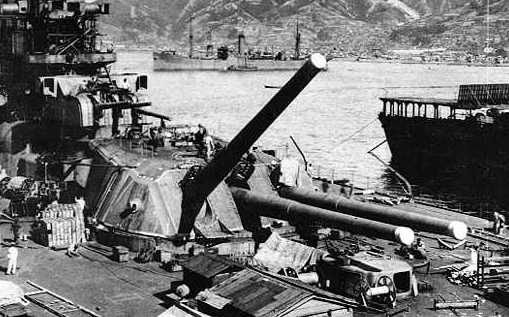|
These guns were officially designated by the Japanese as "40 cm/45 Type 94" (15.9 inch) in an effort to hide their actual size, which was a closely-guarded secret until after the end of World War II. The Yamato is known to have fired at enemy ships on only one occasion. This was at the Battle off Samar in October 1944 against the U.S. Taffy 1 and Taffy 3 escort carrier groups, with rounds possibly hitting USS Gambier Bay (CVE-73). The Musashi is known to have fired her guns in anger only once when she fired "sankaidan" (incendiary shrapnel) anti-aircraft shells during the Battle of the Sibuyan Sea in October 1944. One of these reportedly exploded in the barrel, disabling the gun. A total of 27 guns were produced, with the first one being completed in March 1938 and tested at the Kamegakubi proving grounds. Eighteen of these guns were lost with Yamato and Musashi, two test guns at Kamegakubi were demolished in November 1945 in accordance with the general disarmament orders of the U.S. Army and the remaining seven were found in various stages of completion on the beach in a cove north of Kamegakubi. See picture on the additional photographs page link below. Five of these remaining guns were destroyed while the last two were taken to Dahlgren Proving Grounds in Virginia, USA, for testing. These were reportedly cut up for scrap sometime during the 1950s. Two partially completed turntables intended for Shinano were also captured and later destroyed. These guns had an unusually complex construction, perhaps reflecting the difficulty in manufacturing such a large caliber. The A tube, designated as 2A, had the 3A tube shrunk on for somewhat over half the length from the breech end. This assembly was then wire-wound and had a layer of two tubes shrunk on for the entire length, followed by a two-part jacket at the breech end. The various tube locating shoulders were fitted with Belleville spring washers, presumably to lessen stress concentration and potential "steel choke" problems. This feature was similar to many Vickers designs which used cannelured rings. The inner A tube, known as 1A, was radially expanded into place by applying hydraulic pressure in three separate operations. The inner A tube was rifled after it was in place. There were also a short breech ring and a breech bush screwed into the 3A tube. The breech is believed to have been a Japanese version of the Asbury type with a Welin breech block. A great disadvantage of this type of construction was that the gun could only be relined by completely boring out the inner A tube. This was so expensive a process that it was considered to be more practical to simply replace a worn out gun with a new one, although it does not appear that either battleship was ever regunned during the war. This may be seen as a reflection of the brief combat life of these ships. |

IJN Yamato under construction in September
1941
|
| .
|